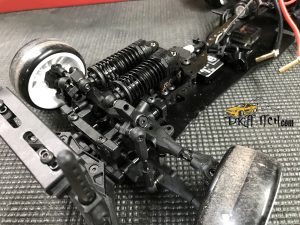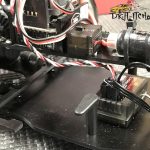
3Racing is sort of the dark horse in the drift world. They always seem to swoop into the scene with an eye catching car that manages to steal some thunder from the bigger players on the scene. Their last release, the Sakura D4 made waves when it landed a few years ago. It had a very competitive price tag and all the crazy mods for it attracted quite a few followers to the platform. It was built with Counter Steer and RWD in mind and those design choices compromised the car in my opinion.
Well those days are long gone. AWD and Counter-Steer are all but dead. The DFIVE S (S for sport version) is a ground-up RWD design and it shows. Clever use of materials and design choices again have allowed 3Racing to bring this car to market with a dirty cheap price point. This car is so inexpensive it will make any level of drifter willing to pick one up just to try. I have been driving 3Racing cars since the D3 hit the market 7 years ago and this latest car just seems all business.. Gone are the pink accents that adorned every version up until now. The car is devoid of swoopy diffusers and bat fins hanging off of the lower arms. The DFIVE just seems like 3Racing is all grown up now and ready to do battle with the rest of the heavy hitters.
So will this car live up to the hype? Read on and find out.
Minimalistic is the best word to describe it
Quality and materials: If I had to describe the D5 in movie car terms it would be from the Mad Max movies. The car is stripped down to the bone including only what is completely necessary to function. The caseless gearbox on the back of this car reminds me of a war machine from one of those post apocalyptic 80s movies. The lack of having to injection mold what would have probably been the largest plastic pieces on the car undoubtedly saves money, allowing them to drive that price point even lower. A cheaper car is one thing but keep your fingers clear during operation.
Maximum use of milled glass fiber plates reduces the need for expensive injection molds and they utilize these milled parts anywhere it is possible. The battery tray, shock towers, even the rear lower arms on the car use these plates. All extremely clever engineering choices designed to get this car into consumer hands as cheaply as possible. Surprisingly none of these thrifty design choices affect the cars ability to perform, but more on that subject later.
A final point I would make in this area is on the plastics. 3Racing is notorious for using extremely hard plastic. Threading anything together with anything but your hands will yield extremely hot hardware which can cause the threads to strip. To avoid this you can use hand tools to assemble but if you aren’t using high quality hex drivers your hands are going to suffer. I purposely left my trusty Ryobi power driver laying to the side so I could see just how hard this kit is to build by hand. This kit, like all the other 3Racing kits I have built felt roughly the same. A little more difficult to thread in a screw than it should be.
Design: When this car hit the market I think many people didn’t know what to expect. The DFIVEs sub 100 dollar price range would lead one to believe that the car may not perform well. The predecessor car; while it could be molded into a performer, it was not stunning right out the box. It was plagued with steering geometry issues that made driving it very frustrating. You can read my full review of it here. Those fears were quickly put to rest as soon as I dropped this car on my test track. Yea I had seen promising videos of this car, but YouTube magic abounds when it comes to RC car reviews. I’m glad to report that the videos did not lie. The DFIVE suffers none of the steering woes of the D4. It’s not without flaw, but a massive improvement.
It will take minimal tuning to dial this car in to run with the best of them. For an 80 dollar car that is an insane statement. But its true.
Other thrifty design choices are with the shocks. 3Racing went with a fully plastic “big-bore” design front and rear. The shock bodies on this thing are massive. This trend has been making its way into off-road for years now, but on a drift car I’m not so sure. Never the less they perform well with no signs of leaking. The pistons are high quality, and the single o-ring cartridge is smooth and consistent. In fact I’m not sure I have felt a better feeling fully plastic shock. The spring choice on the car has me baffled though. The front springs are WAY too stiff for the car. At zero preload the car proudly stands at attention with those huge inboard shocks at full extension. And to my next point, why inboard shocks?
The inboard shock setup works nice and smooth thanks to its ball bearing supported cantilevers. There is no chance of tire/wheel interaction with the shocks using this configuration. This was a very popular mod on some high end drifters in the early days of RWD because it freed up much needed real-estate for extreme steering throw. Back then chassis were often derived from AWD setups that needed space for a front diff or one-way. As RWD designs progressed shocks were able to move further and further inboard eliminating the need for an IFS shock setup. This design choice kind of makes the chassis look dated in my opinion and over complicates the front end of this car. It does not however detract from the performance in any way so no points off for using it.
The last thing I’ll mention here has to do with the servo placement. The DFIVE uses an inverted servo setup reminiscent of some of Yokomo’s later offerings. I’m really not a fan of the setup in either car, but I do think in the DFIVE the limited space in the front of this chassis would not have allowed for much else. This design choice does force you to use a low profile servo, but these servos have been the norm in the drift segment for a good long while so no big deal. The real inconvenience comes into play with the shocks sitting on top of the assembly. It makes getting at the servo out much more involved than it would be normally. Luckily there is a nice sized channel in the bottom of the chassis that allows servo horn adjustment without removing the servo. A minor annoyance and another complication related to the IFS setup.
Handling and Performance: Here is where this car shines. With a complete box stock setup, no weight added for balance at all the car was instantly easy to drive. I was testing on polished concrete which will immediately put a microscope on any setup problems your car has. My personal setup on my RMX2 and YD2 are a rear-mid high-motor setup. Having never driven a fully rear motor car before I was not sure what to expect. My initial feeling with the car is that the extreme rear bias makes the car hang the tail out a little longer than a mid/rear motor car, but I was able to get used to it pretty easily. Within minutes I was comfortable and the tires had worn in nicely. The car could benefit from some softer front springs to get the stance in check and tweak the car a little more to my liking. The super stiff front springs prevent much weight from shifting to the front wheels giving up some much needed low speed steering response. I did find myself snow plowing with it much easier than with my personal cars.
The exposed rear drivetrain worked smoothly and with relatively low noise for having almost all metal gears. I read complaints from some about the gears being noisy, but I did not find them bad at all. I will say that having these gears exposed like this will limit where you can operate this car. Inside on polished concrete or carpet it will probably be fine, but I would avoid driving it where debris could make its way into the gears.
All in all, a little shimming up front, some spring swapping to adjust the stance and compliance and you have a pretty amazing car.
The TLDR:
Likes: PRICE!! OMG this thing is affordable.
Works well with minimal fuss.
Includes body magnets and they are awesome. I have already ordered another set for my other cars.
Tons of upgrades already in the pipeline and lets face it. Blinging it out is half the fun right? A 2.0 version has already been announced and carbon chassis versions are already in the wild.
Problems/dislikes: There were no huge show stoppers in this build.
Upon first assembly the did have a leaky diff. I thought I had cranked the screws down pretty tight but you can’t get a great feel for how tight due to 3Racings super hard plastics. I pulled the diff out and cranked on them again and did get them to bare down a little more. After this I had no more leaking problems.
I had to file one of the rear suspension arms to get the fiberglass plate to sit down flush. There must have been a burr on the plastic preventing it from seating fully. Fixing that added another 5-10 minutes to my build time.
I dislike the battery tray. Its more like a battery guide. It fits in with the other spartan design choices on this car, but filing to make the battery fit? I’ve already seen 3D printed battery trays out there for this car so I know I’m not the only one who does not like this design.
Final thoughts:
Grade: B+
All complaints aside, there is not much that I can’t discount by saying “hey, it’s 80 bucks”. There is no disputing that this car has already made its place beside the RMX 2.0 as the obligatory starter platform. With tuning and a little money this car will be a formidable competition machine. 3Racing has firmly put their stamp on the sub 100 dollar price category. I highly doubt you are going to find something as inexpensive as this that works this well.
Well done 3Racing.
That’s it gang! Thanks for stopping by to check out my review! Be sure to hit up my Facebook page (top right corner of the page) to get notified when a new post goes up!
Keep the shiny side up!
-Evol
Here is a little video I shot of the car. The added weight of the GoPro made the handling a little wonky but you get the idea.





